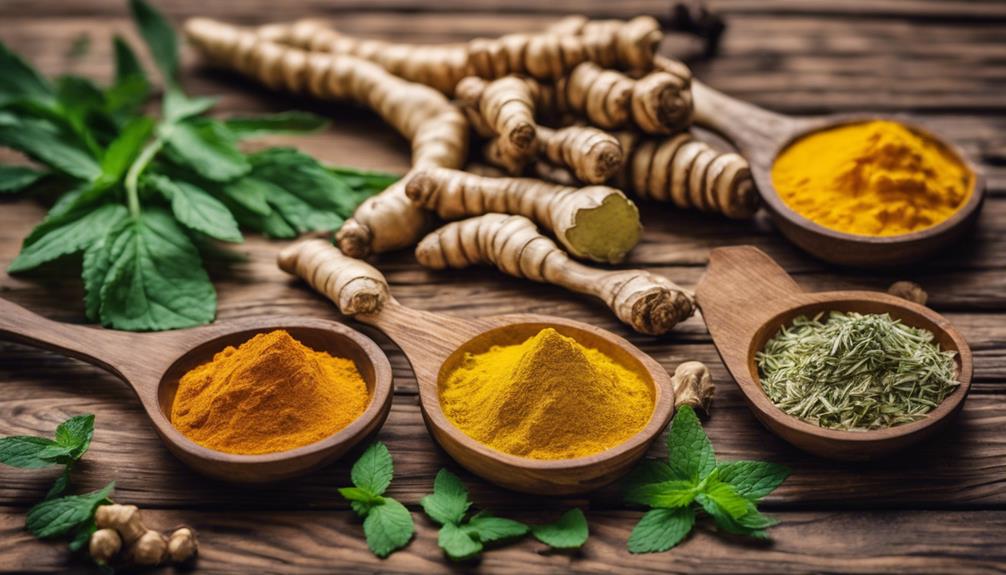Herbal pain relief offers a natural way to ease discomfort without side effects. Popular options include willow bark, which contains salicin—similar to aspirin, and turmeric with its anti-inflammatory curcumin. Ginger helps with soreness and cramps, while lavender and peppermint oils provide quick relief through inhalation or topical use. Incorporating these herbs into your routine can promote overall wellness. Stick around, and you’ll discover more about leveraging these effective, time-tested remedies.
Key Takeaways
- Willow bark contains salicin, a natural compound that converts into salicylic acid, providing effective pain relief similar to aspirin.
- Turmeric’s curcumin offers anti-inflammatory benefits, making it useful for joint pain and inflammation.
- Ginger contains compounds that help reduce menstrual cramps, soreness, and headaches naturally.
- Herbal remedies like lavender and peppermint oils can provide quick relief through inhalation or topical application.
- Incorporating these herbs into teas, meals, or topicals offers a gentle, side-effect-free approach to managing pain.

Have you ever considered using herbs to soothe your pain naturally? Many people turn to herbal analgesics because they’re an accessible and gentle alternative to pharmaceutical drugs. These natural remedies have been used for centuries, often passed down through generations as traditional remedies. They offer a way to manage discomfort without the side effects common with synthetic medications. Whether you’re dealing with headaches, muscle pain, or inflammation, herbs can provide relief in a safe, holistic manner.
Herbal remedies offer a gentle, natural way to ease pain without synthetic side effects.
Herbal analgesics work by targeting inflammation and nerve signals that cause pain. For example, herbs like willow bark have been used for centuries for their pain-relieving properties. In fact, willow bark contains salicin, a compound that the body converts into salicylic acid—the basis for aspirin. Using traditional remedies like willow bark can help reduce pain without relying on over-the-counter medicines. Similarly, turmeric, known for its vibrant color and use in cooking, also acts as an anti-inflammatory agent. Its active compound, curcumin, can help ease joint pain and swelling, making it a popular choice for those with arthritis.
Another herbal analgesic worth mentioning is ginger. Not only does it add flavor to your meals, but it also has potent anti-inflammatory properties that can help reduce pain. Many people find ginger effective for alleviating menstrual cramps, muscle soreness, and even headaches. Incorporating these herbs into your routine can be as simple as brewing a tea or adding them to your dishes. These traditional remedies are often preferred because they come with minimal side effects and are easy to prepare at home.
Lavender and peppermint are also renowned for their soothing effects, especially for headaches and tension-related pain. Applying diluted lavender oil or inhaling peppermint vapor can provide quick relief. These herbs are versatile and can be used in various forms—teas, oils, or topical applications. Their calming properties not only help with pain but also promote relaxation, making them a popular choice for stress-related discomfort.
In addition, understanding the benefits of herbal analgesics can help you choose the best options for your needs, especially considering their minimal side effects and traditional use in pain management. Exploring these age-old remedies allows you to embrace a holistic approach to health and wellness.
Frequently Asked Questions
Are Herbal Remedies Effective for Chronic Pain Management?
You might wonder if herbal remedies are effective for chronic pain management. While herbal efficacy varies, many people find these natural options helpful as part of their pain management strategies. Herbs like turmeric or ginger can reduce inflammation and pain. However, it’s essential to consult your healthcare provider to guarantee safe use and to integrate herbal remedies effectively with conventional treatments, maximizing your overall pain relief approach.
Can Herbal Pain Relief Cause Interactions With Medications?
Think of herbal pain relief like adding a new ingredient to a recipe—you need to contemplate how it mixes. Herbal remedies can cause drug interactions, especially if you’re on medications, so always check with your healthcare provider. Dosage considerations are key; taking too much can increase risks. Just as too much salt spoils a dish, improper herbal use may lead to unwanted effects or reduce medication effectiveness.
How Long Does It Take to See Results From Herbal Analgesics?
The timing variability for seeing results from herbal analgesics depends on your individual response. Some people notice relief within a few days, while others may need a few weeks of consistent use. Factors like the type of herb, dosage, and your body’s unique reaction influence this. Be patient, and monitor your progress. If you don’t see improvement after several weeks, consider consulting a healthcare professional.
Are Herbal Pain Relievers Safe for Children and Pregnant Women?
Imagine a knight’s armor, sturdy but not invulnerable. When considering herbal safety, you must be cautious, especially with children and pregnant women. You should always consult healthcare providers for pediatric considerations and pregnancy safety, as herbal remedies aren’t universally safe. While some herbs may be gentle, others could cause adverse effects. Never assume herbal pain relievers are risk-free—always prioritize professional advice to guarantee everyone’s safety.
What Are the Best Herbal Options for Nerve Pain?
For nerve pain, you should explore the top herbal extracts that act as effective nerve pain remedies. You might consider options like turmeric for its anti-inflammatory properties, skullcap for nerve soothing, and lavender to help relax nerve endings. These natural remedies could provide relief, but always consult with a healthcare professional before starting any new herbal treatment, especially if you’re pregnant or have underlying health conditions.
Conclusion
Think of these herbal remedies as nature’s gentle warriors, ready to fight pain with a whisper rather than a roar. Like a soothing river flowing through rough terrain, they ease your discomfort softly yet effectively. Embrace these natural allies, and let their healing touch be the guiding light on your journey to relief. With each sip and every drop, you’re planting seeds of wellness that bloom into lasting comfort, turning pain into a distant memory.










